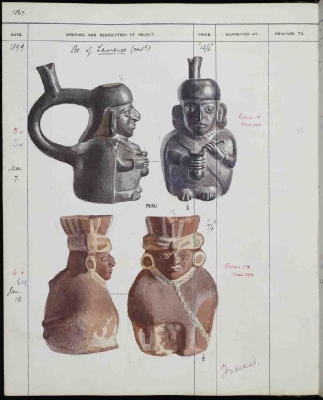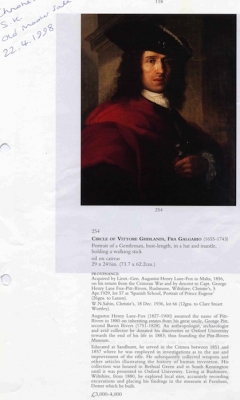To search the RPR site click here
We will never know the total number of objects that Pitt-Rivers acquired over his lifetime, though we can know the minimum number by counting up the number of objects listed in the documentation for the founding collection and in the 9 Cambridge University volumes which catalogue the second collection.
In addition to these there are the items known to have been part of the founding collection before it came to Oxford but not yet found and accessioned (estimated to include several thousand objects). It is also thought that there were items not listed in the second collection catalogue and there must have been many objets d'art which Pitt-Rivers and his wife used to decorate their London homes prior to 1880. We do not have any idea at the present time how many of these there were, or what they were as (so far as is known) no list or catalogue of these possessions exists.
It is therefore known that there were a minimum of:
19,606 objects in the founding collection of the Pitt Rivers Museum (as at 24.5.2010) [1]
20,419 objects in the second collection, 1880-1900 (as at 24.5.2010) [2]
Giving a possible total number of objects collected by Augustus Henry Lane Fox Pitt-Rivers from 1850 until his death in 1900 as
40,025 [1]
The founding and second collection seem roughly to form half of the overall collection each.
This is likely to be an underestimate however. As described elsewhere the founding collection total number may never be known but is likely to be between 20-25,000 objects. In addition there must have been some items not recorded, objets d'art and furniture which Pitt-Rivers collected or owned prior to 1884 which never seem to have been catalogued. It is clear that there are objects acquired before the founding collection was given to the University of Oxford which did not get transferred to Oxford. An example, chosen at random, might be this -- mentioned in 'Primitive Locks and Keys' (1883), 'Figs 23A to 24a, Plate II, is a similar lock used in Norway and copied by me from a specimen in the Hazelius Museum at Stockholm.' This object like others in Pitt-Rivers' 1883 publication about 'Primitive Locks and Keys' show that there are many items which Pitt-Rivers owned which do not feature in the founding collection or in the second collection catalogues. 'Primitive locks' contains reference to many items in 'his collection' (which, of course, at that time could be either in the founding or second collection) none of which appear to be listed in either collection. Indeed there are many items listed as being in his collection in that source which cannot be matched to the catalogues. It is clear that many of them were acquired during trips to Egypt and to Germany after 1880, holidays during which the catalogue of the second collection lists many objects as being acquired, so the omission of the locks seems even more peculiar.
Another example might be the fact that in 1884, during an address delivered to the Annual Meeting of the Dorchester School of Art, February 1884, he exhibited four objects, 2 made by Zulu people and 2 from the Northwest Coast (of North America). (See here for the details of this address.) However, no similar objects are listed in the catalogue of the second collection and these items either were acquired before 1880 but not listed in any catalogue then and not part of the founding collection, or acquired after 1880 but not listed in the catalogue.
A set of objects that were displayed at Bethnal Green and South Kensington Museums were removed shortly before 1884 in order to be displayed at Farnham Museum. Unfortunately these too are not really catalogued and references such as 'Room No. 2 is chiefly occupied by a valuable collection of peasant carvings, mainly from Brittany, which were for some time exhibited by General Pitt-Rivers both at South Kensington and at Bethnal Green' have to suffice (this reference is to le Schonix's account of the Farnham Museum in 1894). [3]
The second collection catalogue does not contain many items from the many excavations carried out after 1880 on Pitt-Rivers' own estates on Cranborne Chase in Dorset/ Wiltshire, these must have been recorded elsewhere (many are now in the collections of Salisbury and South Wiltshire Museum). It also does not contain items which were on display at Farnham Museum but not listed in the catalogue like the excavation models and models of Celtic crosses etc that Pitt-Rivers caused to be made for him. It also excludes the comparative paintings done by various groups of people which were displayed in Room 7. It is clear, also, that it does not contain other objets d'art which became a part of his public collections, for example the bronze statue of 'Caesar Augustus', which was a cast of the original by A. Nelli in the Vatican Museum, said to have been displayed outside Farnham Museum by Salisbury and South Wiltshire Museum where it now resides on the back lawn.
AP, 24.5.2010, updated August 2011, updated Note 1 below in February 2013 to make clear that the overall figures given here above for the founding collection are likely to be an underestimate of the total size of the founding collection.
Notes:
[1] See here to find out why this number is likely to increase. Note that by February 2013 this figure had increased to 22830 thanks to the work of the Excavating Pitt-Rivers project, and the work that museum staff had done accessioning found unentered founding collection arrows. It is likely that if every known but not yet found founding collection object is retrieved and belatedly accessioned the founding collection will number in excess of 25,000 which is nearly double the original estimate used by Blackwood et al of 14,000 objects.
[2] This number may go up very slightly as the project progresses and the proof reading is completed.
[3] le Schonix, R. 1894. 'The Museums at Farnham, Dorset, and at King John's House, Tollard Royal', The Antiquary 30, 166-71





